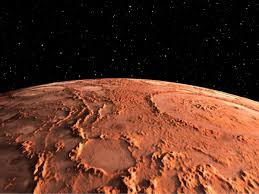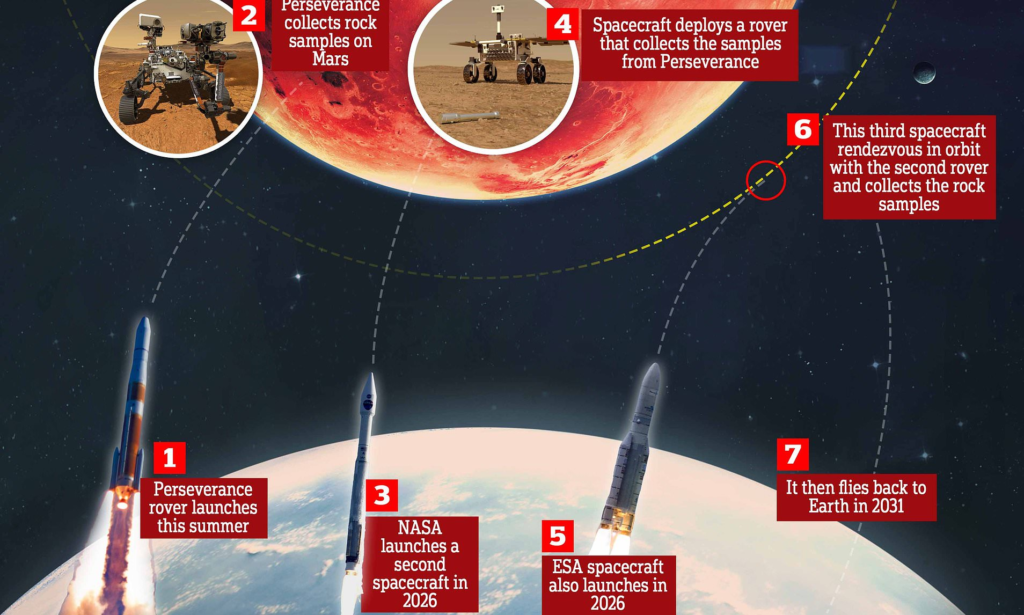In a significant shift, NASA has announced a major overhaul of its ambitious Mars Sample Return (MSR) mission, driven by escalating costs and an extended timeline that agency officials deemed unsustainable. The revised plan aims to retrieve rock and soil samples collected by NASA’s Perseverance rover from the Martian surface and bring them back to Earth for detailed scientific study. This mission, a collaboration with the European Space Agency (ESA), could unlock secrets about Mars’ geological history and the potential for past life on the Red Planet. However, budget constraints and scheduling challenges have forced NASA to rethink its approach, sparking both excitement and debate within the scientific community and beyond.

The Importance of Mars Sample Return
The Mars Sample Return mission is one of NASA’s most groundbreaking endeavors. Since landing in Mars’ Jezero Crater in February 2021, the Perseverance rover has been diligently collecting samples of rock, soil, and even Martian atmosphere. These samples, stored in hermetically sealed tubes, are critical for scientists hoping to analyze them in state-of-the-art laboratories on Earth. Unlike the limited instruments on the rover, Earth-based labs can use advanced tools to study the samples for signs of ancient microbial life and to better understand Mars’ climate and geological evolution. This mission could provide the first direct evidence of life beyond Earth, a milestone in human exploration.
However, bringing these samples back is no simple task. The original plan required a complex series of maneuvers, including landing a spacecraft on Mars, transferring the samples from Perseverance, launching a rocket from the Martian surface, and rendezvousing with an ESA orbiter to return the samples to Earth. The initial cost estimate for this mission was around $6 billion, with a target return date in the early 2030s. But a 2023 independent review revealed a stark reality: the mission could cost up to $11 billion and take until 2040 to complete, a timeline NASA Administrator Bill Nelson called “simply unacceptable.”
Why the Overhaul Was Necessary
The ballooning budget and delayed timeline prompted NASA to reassess the mission. Budget cuts totaling $5 billion over the 2024 and 2025 fiscal years further strained the agency’s resources, making the original plan financially unfeasible. Additionally, the mission’s complexity, which included untested technologies like launching a rocket from Mars, raised concerns about technical risks. NASA faced pressure to find a more cost-effective and faster approach to achieve the mission’s scientific goals.
In April 2024, NASA called on its research centers and private industry partners, including companies like SpaceX and Blue Origin, to propose innovative solutions. The result was a revised strategy unveiled in January 2025, presenting two streamlined options to bring the samples back by the mid- to late 2030s at a reduced cost of $5.5 billion to $7.7 billion. These options aim to simplify the mission architecture while maintaining its scientific integrity.

The Two New Plans
NASA’s revised approach focuses on two distinct strategies to retrieve the samples, both leveraging the Perseverance rover’s existing cache and the ESA’s Earth Return Orbiter. The first option uses a scaled-up version of the “sky crane” technology, successfully employed to land the Curiosity and Perseverance rovers. This method involves a lander equipped with a Mars Ascent Vehicle (MAV), a small rocket that would launch the samples into Martian orbit. The lander would also feature a robotic arm to collect the samples from Perseverance or a designated depot on Mars. This option, estimated to cost between $6.6 billion and $7.7 billion, relies on proven technology to reduce risk.
The second option explores commercial partnerships, potentially with companies like SpaceX, to develop a “heavy” Mars lander capable of delivering the sample collection spacecraft and the MAV. This approach could cost between $5.8 billion and $7.1 billion, offering potential savings but introducing new variables due to the reliance on proprietary commercial technologies. NASA has not disclosed specific details about these proposals, citing proprietary concerns, but the involvement of private industry signals a shift toward leveraging commercial space capabilities. Both options would use a radioisotope thermoelectric generator (RTG) for power, ensuring reliability in Mars’ harsh environment.
Challenges and Opportunities
The revised plans aim to deliver the samples as early as 2035, a significant improvement over the 2040 timeline, though delays could push the return to 2039. NASA emphasized that the new approaches reduce technical complexity and cost while maintaining the mission’s scientific value. However, challenges remain. Landing a heavy spacecraft on Mars is difficult due to the planet’s thin atmosphere, which offers little resistance for parachutes. Additionally, the mission requires precise coordination between the Perseverance rover, the lander, and the ESA orbiter, a logistical feat never before accomplished.
The involvement of commercial partners like SpaceX could accelerate innovation but also raises questions about reliability and oversight. Robert Zubrin, an aerospace engineer and critic of the original MSR plan, has argued that NASA’s focus on a single, complex mission might limit broader exploration efforts. Despite his criticisms, Zubrin opposes canceling the mission outright, highlighting the scientific value of the samples.
Broader Implications
The overhaul comes at a time of transition for NASA. With a new administration under President Donald Trump taking office in 2025, the final decision on the MSR mission, expected in 2026, will likely be influenced by political priorities. Proposed budget cuts in Trump’s 2026 plan have raised concerns among experts, who warn that canceling the mission could set back Mars exploration significantly. The samples, carefully collected from Jezero Crater—an ancient river delta thought to have once been habitable—are seen as critical for informing future human missions to Mars.

China’s Tianwen-3 mission, set to launch in 2028 and return samples by 2031, adds urgency to NASA’s efforts. While China’s mission is a simpler “grab-and-go” approach, NASA’s plan prioritizes carefully curated samples from diverse locations, offering greater scientific potential. The race to return Mars samples underscores the global interest in understanding the Red Planet and its potential to answer fundamental questions about life in the universe.
Looking Ahead
NASA’s revised plans reflect a pragmatic response to financial and technical challenges, balancing ambition with feasibility. The agency is optimistic that one of the two options will succeed, with launches for the lander and orbiter potentially starting as early as 2030 and 2031, respectively. However, securing consistent funding from Congress, including an immediate $300 million allocation, is critical to maintaining this timeline.
For scientists, the stakes are high. The samples could reveal whether Mars ever hosted life and provide insights into the planet’s climate and geological history. For the public, the mission represents a bold step toward unraveling the mysteries of our solar system. As NASA navigates these challenges, the world watches closely, eager for the day when Martian rocks arrive on Earth, potentially rewriting our understanding of the cosmos.
NASA Overhauls Plan to Bring Mars Samples Back to Earth, Citing Budget and Timeline Concerns
Introduction
NASA has announced a major overhaul of its Mars Sample Return (MSR) mission to address escalating costs and delays. The mission aims to retrieve samples collected by the Perseverance rover and bring them to Earth for study, potentially revealing evidence of past life on Mars.
Why the Mission Matters
The Perseverance rover, operating in Jezero Crater since 2021, has collected rock, soil, and atmospheric samples. These could provide insights into Mars’ geological history and the possibility of ancient microbial life, but only if analyzed in advanced Earth laboratories.
Challenges with the Original Plan
The original MSR plan was projected to cost $11 billion and take until 2040, far exceeding NASA’s budget and timeline expectations. Budget cuts and technical complexities, such as launching a rocket from Mars, prompted a reevaluation.
The New Strategies
NASA is exploring two options:
- Sky Crane Approach: Uses proven sky crane technology to land a spacecraft with a Mars Ascent Vehicle (MAV) and a robotic arm to collect samples. Estimated cost: $6.6–$7.7 billion.
- Commercial Partnership: Relies on private companies like SpaceX for a heavy lander to deliver the MAV and sample collection system. Estimated cost: $5.8–$7.1 billion.
Both options aim for a sample return between 2035 and 2039, using an ESA orbiter to bring the samples back to Earth.
Looking Forward
The revised plans reduce costs and complexity, but challenges like funding and Mars’ thin atmosphere remain. With a decision expected in 2026 and competition from China’s Tianwen-3 mission, NASA’s efforts are critical for advancing our understanding of Mars and the solar system.
Also know :- 4.1 Magnitude Earthquake Rattles Tennessee, Felt in Atlanta and North Carolina






